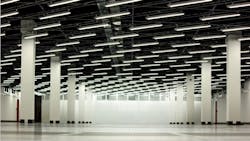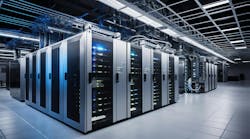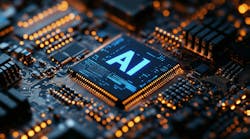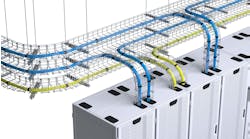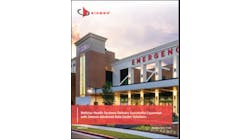Sustainable Lighting: Key Considerations For Green Data Centers
Tim Miscovich, Chief Commercial Officer at wtec shares his insights on the impact of data center lighting and how your lighting plays a key role in your green data center strategy.
Creating a more sustainable future has been a critical focus for many leaders in the data center and technology space. Being able to squeeze every ounce of efficiency out of your systems ensures not only more significant levels of performance and redundancy but also more efficiently run systems.
Tim Miscovich, CCO of wtec Inc.
With efficiency comes greener approaches to critical infrastructure. This is where it’s essential to take a quick pause. During a time of uncertainty, people need to be certain about their technology platforms. This is why we’re seeing more remote workers, more demands from data center providers, and more users leveraging digital solutions to stay connected and productive. This also means more compute, server, and infrastructure instances; and more power requirements to support it all.
According to NRDC, in 2013, U.S. data centers consumed an estimated 91 billion kilowatt-hours of electricity, equivalent to the annual output of 34 large (500-megawatt) coal-fired power plants. In a more recent study, published in the journal Science in 2020, it was reported that data centers accounted for about 205 terawatt-hours of electricity. That’s a big jump, and it’s a number that only continues to grow.
Numerous trends are indicating that more organizations are going to be placing their environments into some data center. This means enterprise, colocation, or even cloud. From there, energy efficiency and data center management will continue to be key considerations for a few reasons. First, not only are data center administrators working hard to cut costs, but a significant business objective is also to minimize management challenges and improve infrastructure efficiency. From experience in working with several different data center providers, we’ve seen that to accomplish this and get to a greater level of efficiency, it’s actually useful to examine all the details, even the little ones. Like intelligent lighting systems, for example.
Did you know: One Google search can power a 100W standard light bulb for 11 seconds
Optimizing the interior workings of a data center or critical infrastructure is a fantastic way to improve efficiency and scale up your sustainability efforts. Far beyond ‘motion’ sensors, the way we light up (or create lights-out) data centers is through a system of interconnected, smarter solutions.
For example, advanced and connected lighting systems leverage power and control over a standard IT infrastructure along with a fine mesh sensor network. Sensors on each luminaire detect motion, brightness, temperature, and per fixture power consumption – and deliver this data to the intelligent processing engine in real-time. The networking of rooms and buildings via next-gen sensors makes it possible to quickly obtain a detailed understanding of how spaces are being used, all the while delivering lighting energy cost savings and improved efficiency, often measured between 0.1-0.3 W/Ft². This compares to more traditional lighting power densities which often measure around 0.6-1.0 W/Ft². Comparably, that’s quite a bit more.
From an efficiency perspective, you can create automated sustainability by leveraging these types of connected systems. You’re not only turning lights on and off. You’re also using data to understand the surrounding environment data and how people are interacting with rooms, facilities, cages, and more. For example, these types of solutions are capable of autonomously managing HVAC systems. So, for office spaces, open areas, and so on, you can leverage motion data from sensors to engage or disengage the HVAC system as needed. In some real-world use-cases, that has demonstrated upwards of a 30% energy savings on HVAC spend.
A smarter way to save the environment
There are so many ways to create more efficient technology environments. However, the inside workings of a data center are often overlooked or saved for last. If you’re simple motion sensors just turn lights on or off, you’re missing out on a crucial part of your technology ecosystem. That is, the ability to gather and act on valuable data.
Traditional lighting systems help you keep the lights on and off, of course. However, intelligent lighting systems with sensors and connected devices also help with:
- Real-time space occupancy and usage
- Heat maps
- Data exports
- Visualization tools
- Deep analytics
- API integration
From a security perspective, they’re much more locked down as well. As opposed to working with, for example, PoE and IP-based solutions, new connected platforms allow you to leverage both VLAN deployment options alongside MAC address security. That is, there will be no easily accessible IP address for the malicious actor ever to try to take advantage of. And, this means your data will never be leaked from these devices as all data is stored locally.
New solutions don’t only have to offer a greener way to a data center. They can also be more secure, more efficient, and help you reduce management headaches. We spend a lot of time focusing on airflow, power sources, building design, and servers. However, when it comes to lighting and designing interior components, it’s often saved for last. So, whether you’re building a new facility, or are looking at ways to optimize your existing technology ecosystem, know that lighting systems are here for far more than just keeping the lights on. Modern solutions integrate intuitive controls, optimization around the entire environment, and provide deeper insights and data points into how your data center is being accessed and used. If anything, these new systems can undoubtedly shed some light on how to become far more efficient and sustainable.
Tim Miscovich, is the Chief Commercial Officer at wtec, makers of smartengine which offers data center and smart building solutions.
